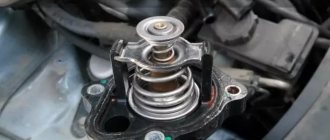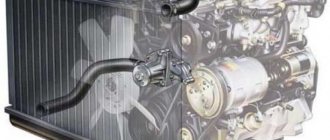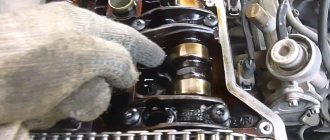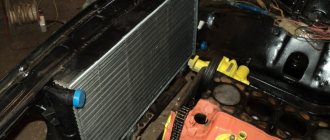An internal combustion engine can only operate within a narrow temperature range. Deviation to a smaller or larger direction leads to increased wear and damage to the motor. The main purpose of the thermostat is to maintain optimal operating conditions. It helps speed up the engine warm-up process, and in the event of impending overheating, it ensures a decrease in coolant temperature. Failure of the thermostat can result in the engine boiling, which can cause significant damage to the power plant, so at the first suspicion that the device is not working properly, it is necessary to diagnose the engine cooling system.
Block diagram of the thermostat
Historical excursion
Automobile manufacturers have been serially installing a thermostat in liquid cooling systems since 1922. This was due to the advent of power plants that generate large amounts of heat, in which standard heat transfer fins no longer cope with the task assigned to them. A thermostat became necessary to prevent the consequences of overheating the engine.
The first designs did not provide high operational reliability. In the process of improving automobile thermostats, several main types of thermostats have appeared. Their design was very different; for example, the filler could be liquid or solid. Modern devices have acquired electronics that allow them to receive control signals from an electronic controller.
Appearance and modernization of the device
One of the first thermostats is considered to be the appearance of a mercury device for maintaining optimal temperature balance in a chicken incubator, which was invented in 1620 by Mr. Cornelius Drebbel from Great Britain.
The thermostat has been actively used in the liquid cooling system of internal combustion engines since 1922, when the first and relatively powerful units with large heat release during operation appeared. Early on, there were several unsuccessful attempts to use the device in a cooling system. Further, the design was improved, engineers selected optimal manufacturing materials and achieved such characteristics and reliability that the thermostat became a widely used element in the liquid cooling system of an internal combustion engine.
We also recommend reading the article about the design of a centrifugal pump for an internal combustion engine liquid cooling system. From this article you can learn about the design features of the pump, its functions in the cooling system, features of operation and repair of the pump.
There are two types of thermostats used in car cooling systems. There are solutions with solid or liquid filler. The gel thermostat for automobile liquid engine cooling systems was invented by a Frenchman named Serge Vernier in 1963. The Vernet company specializes in the production of thermostats today, and the products of this brand enjoy well-deserved authority in the auto parts market for various brands of cars around the world.
Thermostat filler
The thermostat can have various types of filler at the core of its design. We have already mentioned that there is a liquid filler and a solid filler. The operating principle and design of these solutions are almost the same. The differences lie only in the increased sealing of the liquid structure, as well as in the individual physical properties of the filler itself and its sensitivity to temperature fluctuations, depending on the composition.
Modern engines have received this type of device, which is based on a solid filler. By such a filler we mean the main thermoelement, which is initially in a solid physical state inside the thermostat.
Functions and location
Once the engine reaches its optimal operating temperature, it becomes necessary to maintain this indicator within strict limits until the very moment the engine stops, and in some cases, for some time after the engine stops operating. The main task of the device is to control and distribute the flow of heated cooling liquid inside the system to remove heat from the engine.
The thermostat can be located in different places, depending on the engine layout in the engine compartment, and the location of its installation directly depends on the model of the power unit. Also, the installation location of the device is influenced by the design features of the implementation of the cooling liquid system itself. In most cases, the thermostat is located where the coolant exits the cylinder head. The second most common location for its installation is the inlet of the centrifugal coolant pump (pump).
Operating principle of a solid-fill thermostat
The mechanical valve is the main structural unit that distributes antifreeze flows. It is controlled by a heat-sensitive element, which is often used artificial wax, located in a sealed chamber. Its melting leads to an increase in the occupied volume. The wax compresses the rubber chamber. It, in turn, acts on the chrome-plated metal rod. The activated valve opens or closes the flow of fluid, which is the main principle of how the thermostat works.
Example of coolant flow distribution
For greater stability of the temperature-sensitive element, in addition to granulated petroleum wax, its mixture with graphite, copper or aluminum fine particles can be used. The main requirement is stable expansion during the transition from solid to liquid and vice versa. This allows you to precisely regulate the temperature of the engine by releasing liquid into a large or small circle. The diesel thermostat is structurally similar to the gasoline version of the internal combustion engine.
Solid thermostat
Installing and replacing the thermostat
The specificity of the thermostat design for each specific car model makes it possible to replace a failed part only with an original one, with the exception of some models that are similar and interchangeable. To replace the thermostat, you will need a screwdriver, appropriate keys and sealant, as well as a container into which the coolant is drained before dismantling the part. Work is carried out on a completely cooled engine in the following order:
- Providing access to the thermostat by dismantling individual elements of the engine compartment (air duct, battery, air filter).
- Loosening the clamps and disconnecting the supply hose from the radiator side, the pump tube and the inlet pipe from the thermostat.
- Removing the thermostat.
Installation of the product is carried out in the reverse order. If necessary, apply sealant to the joints with pipes or under external gaskets. Before installation, it is checked by immersing it in water with a temperature of about 80 ° C, in which the valve should open, which indicates that the thermostat is working.
Operating principle of a liquid filled thermostat
The operating principle of a thermostat with a bellows is similar to devices with a solid filler. The main difference is that the temperature-sensitive element is a mixture of distilled water and ethyl alcohol. When the engine is cold, evaporation does not occur inside the sealed cylinder and there is no excess pressure. The thermostat valve prevents coolant from circulating through the radiator.
Thermostat with liquid filler
When the engine heats up, ethyl alcohol begins to evaporate rapidly. The pressure in the cylinder increases. The bellows, which expands in length, acts on the stem and the valve opens. After this, the antifreeze enters the large circulation circle instead of the small one.
How to make something reliable unreliable, or Why does a thermostat need electronic control?
The developers of the first water-cooled engines coped with the task of preventing overheating, which was extremely dangerous for engines, by using the property of water to rise upward when heated. The scheme was simple: the upper tank of the radiator, where the hot water rose, was placed above the engine, from the upper tank the water descended through the radiator tubes, cooled along the way, and then returned to the engine.
A little later, in order to speed up cooling and make do with a relatively small amount of water, the radiator was ventilated using a fan that constantly rotated while the engine was running. The cooling system began to cope even more effectively with the responsibilities of protecting against overheating when the water cycle in the engine was accelerated using a water pump.
The disadvantages of such cooling systems were the long preheating of the engine to operating temperature and its low value at low ambient temperatures. The bad thing is that in an unheated engine, mixture formation worsens, and the engine oil remains excessively viscous. Hence the loss of power and excessive fuel consumption. In addition, since in a cold engine the fuel not only evaporated poorly, but, having evaporated, tended to become condensate again, its droplets diluted and washed away the oil, which caused the power unit to wear out faster.
The result of the fight against the shortcomings was the appearance in the cooling system of two instead of one circulation circle - large and small. In a small circle, essentially including only the engine cooling jacket, into which heat from the hottest parts of the engine is directly transferred, the liquid circulates after starting. This allows it to quickly reach the desired temperature and the engine to warm up just as quickly, minimizing the problems of cold operation.
The liquid is sent into motion in a large circle, or, more simply, through the radiator, only when there is a threat of overheating. Then all that remains is to regulate the intensity of fluid circulation through the radiator until the large circle is completely turned off if the temperature drops too much.
Such operation of the cooling system is achieved, and with it - automatic maintenance of the most favorable temperature conditions of the engine thanks to the thermostat.
It is he, like a switchman, who chooses the path along which the water pump, depending on the temperature, will drive the coolant, and the automatic operation of the thermostat is ensured by the use in its design of an element containing a filler, the volume of which changes greatly during heating and cooling.
Fillers can be liquid or solid, but thermostats with liquid filler that were widely used in the past turned out to be not very durable. This ultimately led to a widespread shift to solid-fill thermostats. When heated, the filler in them melts and expands, affecting the thermostat valve stem. The valve opens and allows fluid to flow into a large circulation circle.
The temperature at which this occurs can be seen on the thermostat valve plate. When the temperature drops below the specified one, the filler from the liquid state becomes solid again, and its volume decreases, while the valve, under the action of the return spring, blocks the passage of liquid into the radiator. This will continue until the liquid, circulating in a small circle, heats up to the required temperature and, washing the working element of the thermostat along the way, forces the filler to melt and expand again.
The disadvantage of thermostats with one valve is the lack of clarity in redirecting the flow of liquid from a large circle to a small one and vice versa. The point is the hydraulic resistance that is created by the radiator. Work to reduce the size of radiators while maintaining their efficiency led to an increase in hydraulic resistance, due to which the liquid, even after opening the large circle, tended to circulate along the path of least resistance, which was the small circle.
The fight against this problem led to the emergence of two-valve thermostats. In them, when the main valve opens the passage to the large circulation circle, the small circle is closed by an additional valve.
However, no matter how many valves you attach to the thermostat, there was another drawback that you had to put up with for a long time due to the lack of a way to deal with it. The thermostat provided the required temperature conditions under any atmospheric conditions, which was good, and under any engine load, but this was bad, because what was optimal under one load ceased to be so when it changed.
For example, to reduce fuel consumption and reduce exhaust toxicity during engine operation at partial loads, it is desirable that the coolant temperature be as high as possible. At light loads, it should even balance on the verge of liquid boiling, which for modern cooling systems operating with excess internal pressure is approximately 105-110°C.
However, when the engine operates at this temperature, the air entering the cylinders heats up and expands, which leads to a decrease in the filling of the cylinders. Not enough air means you won't burn much fuel, which is a loss of power that is required when the engine is running at or near full load. Therefore, for such load conditions, the coolant temperature should not be higher than 85-95°C.
No thermostat, subject to phase transformations of the filler from solid to liquid and vice versa, is able to optimize the temperature of the coolant according to the needs of load conditions. The situation seemed deadlocked until, in connection with the development of electronics, someone came up with the idea of adding electronic control to the standard algorithm of the thermostat.
To do this, in addition to the filler, a heating resistor was placed in the working element of the thermostat. The thermostat itself was set to operate at significantly higher temperatures than the large circle valve opens in conventional thermostats. This made it possible to maintain the coolant temperature around 110°C while the engine was running at partial load. However, as soon as full output is required from the motor, current is supplied to the resistor. Next begins what happens in conventional thermostats due to heating by the coolant, but now the source of heat is not it, but the heating resistance. The engine control unit commands the resistance operation according to its coolant temperature optimization program.
Is it a good idea? There would be no doubt about this if, in addition to the front side of any medal, there was not also a reverse side. Any complication of the design, no matter how interesting it may look from a technical point of view, leads to a loss of reliability.
Take, for example, a two-valve thermostat. If a single-valve thermostat fails when open, the engine will take a long time to warm up, its temperature drops when the car is moving, cold air blows from the stove, fuel consumption increases, but nothing more serious will happen to the engine. However, such a malfunction of the two-valve thermostat can lead to engine overheating. This seems unthinkable, but such cases have been observed in practice.
There is nothing surprising about this. The default operating principle of a single-valve thermostat assumes that after opening the valve, some part of the liquid will still continue to circulate in a small circle, but the operation of a two-valve thermostat a priori excludes this. This is what is counted on during design, but malfunctions make adjustments to the calculations of engine developers.
What adjustments has electronic control made? Obviously, to the reasons that caused the failure of thermostats with a traditional device, new ones were added related to the presence of a resistor, its wiring and its contact connections that can oxidize, as well as additional seals that sooner or later stop sealing.
Only the developers probably know how much fuel electronic control allows you to save and how much cleaner it makes the exhaust; specific figures could not be found in the available sources of information. But from the spare parts catalogs it is not difficult to find out how the complication of the design affected the cost of troubleshooting. If previously, to buy a good non-original thermostat for most cars common in Belarus, it was enough to find 9-15 USD, then an electronically controlled thermostat will cost no less than 60-80 USD.
External causes also appeared, for example, failures of sensors, the information of which is used to electronically control the thermostat. This in turn changed the approach to troubleshooting. Previously, experienced motorists assessed the performance of the thermostat by touch, by how the hoses for supplying and discharging fluid from the radiator heated up. Now only the operation of the fan can be alarming when there is no reason for it (the engine is cold, the air conditioner is turned off), which means switching to emergency mode. But in order to understand which direction to dig in order to find a specific culprit, it is problematic to do without computer diagnostics.
Finally, the engines themselves became “hot”. For them, the slightest malfunction in the cooling system, to which motors with conventional thermostats did not respond or responded with minimal consequences, can turn out to be fatal. The increase in engines that are said to be very sensitive to overheating appears to be a major consequence of the evolutionary changes that thermostat design has undergone.
Sergey BOYARSKIKH Photos by the author and from open sources ABW.BY
Thank you for your help in organizing the “Resource Center” photo shoot on the basis of the Automotive College named after Academician M.S. Vysotsky
Types of thermostats
Design options for thermostats include:
- single-valve technical solution;
- two-stage implementation;
- two-valve device;
- electronic control.
Single-valve technology has gained the most popularity. It is simple and reliable. Cars of past years predominantly had this type of thermostat. The two-stage design became a necessary measure caused by high antifreeze pressure. The thermostat valve was not able to overcome the force, resulting in small and large plates in the design. The smaller one opens first, as it is subject to slight coolant pressure. During the second stage, the main plate is added and all the antifreeze is directed into a large circle.
The two-stage implementation has only one valve. In contrast, the design of a two-valve thermostat involves the presence of two separate control devices combined in one housing. Each valve is responsible only for its own circle of coolant circulation. The most important thing in the design is the synchronization of the operation of each part of the device.
Electronic thermostat
Automakers managed to achieve maximum accuracy in operation by equipping the thermostat with electronic control. The design difference with the classic model is the presence of a heating resistance. The thermostat maintains the engine temperature at 85-95°C at high loads and 95-110°C in other engine operating modes. This allows you to reduce fuel consumption and get a slight increase in power. The thermostat receives the control signal from the injector ECU. In the case of a diesel engine, the temperature ranges may be different.
Characteristic
The thermostat is one of the structural components of the cooling system, which controls the flow of antifreeze.
- Fast engine warm-up.
- Maintaining its optimal temperature (usually the range from 85 to 95 degrees).
We also note that there is also a washing machine thermostat. It was checked with an ohmmeter by connecting probes to the contacts. As a result, the device should produce a resistance of 1350 Ohms.
But let's return to classic thermostats. They work according to the following principle. After starting, the liquid begins to circulate in a small circle. This is the heater radiator and the motor itself. As a result, the engine warms up faster and warm air is provided in the cabin (which is especially important in winter). As soon as the coolant temperature exceeds a predetermined level (usually from 70 to 80 degrees Celsius), the valve of the device opens and the antifreeze flows into a large circle, including the main cooling radiator. The latter is located immediately behind the car's radiator grille.
Design features of thermostats
Structurally, thermostats are divided into cased and uncased. Each type has its own advantages. The leader at the moment is still a thermostat with a shell.
The case thermostat, regardless of the internal filling, has at least two outputs. Thermostats are made of brass, aluminum, and plastic. The device does not have manual control of the response temperature.
Cabinet thermostat
The frameless thermostat is mounted in the engine block. For these purposes, a special place is provided in the engine. The temperature characteristic of the thermostat is applied using digital markings. The appearance of the frameless regulator is shown in the image below.
Frameless thermostat
Cost of parts and repairs
Most auto repair shops recommend replacing the thermostat every 3-5 years, without waiting for problems to arise. It is most convenient to do this together with diagnosing the cooling system or replacing the coolant. The cost of this work is low, it all depends on the position of the part under the hood and the car manufacturer.
The car market responds to demand with a wide range of both universal ones, designed for almost any engine, and individual copies. Domestic production will be an order of magnitude cheaper than imported analogues. For example, the cost of a Russian unit for a VAZ will be about 300 rubles. While a foreign device has a price of 600 rubles and above.
Major device failures
The most dangerous failure is the thermostat getting stuck in the closed position. Overheating of the engine leads to a decrease in its service life and accelerated aging of the oil. Under unfavorable conditions, serious damage may occur after the engine boils, which can only be corrected by a major overhaul.
After the valve is stuck in the open position, the antifreeze circulates in a large circle all the time. The engine takes a long time to warm up, especially in winter. Running the engine at temperatures below normal speeds up the process of engine wear.
Recommendations for use
Domestic cars often experience problems maintaining engine operating temperature. Moreover, this can occur even with a working thermostat. To solve this problem, experts recommend using different thermostats seasonally. For example, in winter, drive with the element at 85 degrees, and in summer - at 75. This way the car will warm up faster in winter and not boil in summer. Also, you will not experience problems with a cold stove.
Symptoms of a problem
The main signs of the need to diagnose the thermostat are:
- engine warm-up has become longer;
- the lower pipe heats up simultaneously with the engine warming up;
- the temperature is rapidly moving into the red zone;
- after overcoming the plug, the lower pipe is cold and the engine is close to boiling.
Thermostat malfunctions can also include loss of tightness. If antifreeze leaks are noticed, it is necessary to locate the leak. Reduced coolant levels can cause the engine to overheat.
When to change a part
Signs that the thermostat on your refrigerator needs to be replaced are the following:
- continuous operation of the compressor (the motor does not turn off on its own, the device must be disconnected from the network);
- the refrigerator compartment begins to freeze more strongly, and the freezer may begin to thaw;
- The refrigerator switches off spontaneously, the compressor no longer starts or makes any sounds.
The cause of each of the symptoms may be a breakdown of the thermostat. Do-it-yourself troubleshooting helps save money.
Thermostat diagnostics
A normally functioning thermostat does not require the attention of the car owner. Intervention into the operation of the cooling system will be required if there are signs of overheating or the engine has been warming up for too long. In this case, first of all, you need to start with diagnosing the thermostat. It is recommended to follow the following plan:
- Evaluate the operation of the thermostat without removing it from the car. It is necessary to visually assess the temperature of the pipes. in this way you can calculate whether the thermostat is stuck in the open or closed position;
- Remove the thermostat. Place it in a container of water and begin heating, controlling the extension of the rod. If the valve does not open in boiling water, then in the event of overheating the thermostat will not redirect coolant to the radiator.
Checking the Thermostat
During the operation of the car, it is necessary to constantly monitor its temperature conditions. Having discovered a malfunction of the thermostat, it is necessary to diagnose and repair the cooling system as soon as possible. Otherwise, the engine may boil and subsequent expensive repairs may occur.
If you have any questions, leave them in the comments below the article. We or our visitors will be happy to answer them
What is it and how does it work
As you understand, the thermostat is a component of the cooling system of a car engine.
In short, the task of this element is to open and close the path for the movement of fluid that flows through a small or large circle.
The operation of the device is based on a physical phenomenon. Namely, on the expansion of the liquid when it is heated. The thermostat has a rather simple device, although in fact it is a sensor and an actuator in one bottle. It consists of a cylinder which is filled with a waxy liquid, powdered copper, aluminum and graphite. There is also a rod located inside the cylinder and a pair of spring-loaded valves. One valve is for the main (large) one, and the second is for the small circle of circulation of the cooling liquid.
During operation, this element is constantly exposed to the liquid that washes it. Heat is transferred to the contents of the cylinder.
When heating occurs, the wax in the cylinder expands, the rod is squeezed out along with the valve, marking the small circle. Thus, the small circulation circle is blocked, and the liquid begins to pass through the engine radiator, and not just through the stove radiator.
Where is the thermostat located in the car?
This important component in the cooling system is usually located between the radiator and the engine. It is a small housing device with two pipes and a valve that regulates the temperature of the antifreeze. Mostly made of brass, less often - of copper or plastic.
The thermostat must contain technical wax, which promotes expansion of the mechanism from high temperatures and rapid cooling.
On modern foreign cars, the coolant temperature regulator is located deep in the engine compartment. To get to it, you have to remove some parts. For example, on many Mercedes models, including class C, the filter air duct is removed or displaced.
Thermostat location











